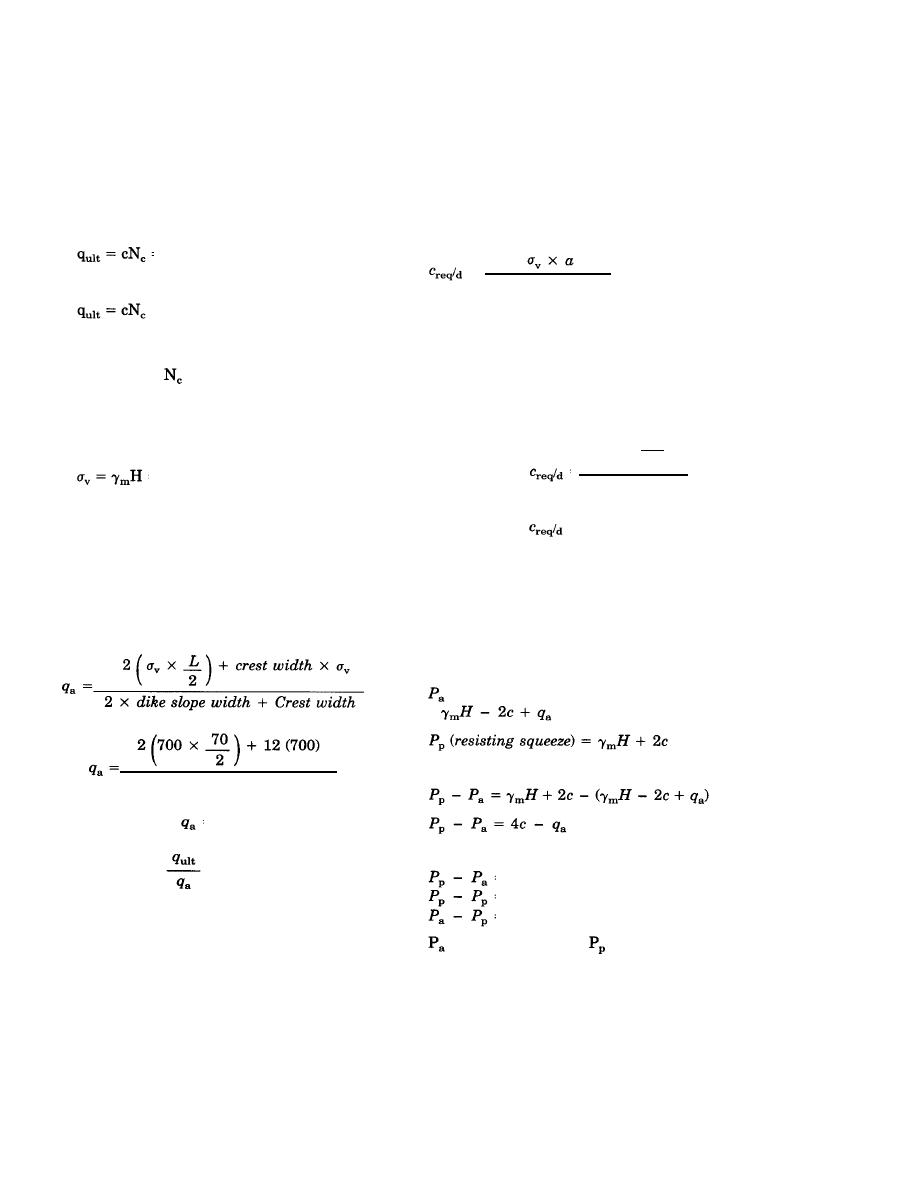
TM 5-818-8/AFJMAN 32-1030
b. Factor of Safety. This design example will
4-5.
Bearing-Capacity
Consideration
consider an FS of 1.3 against rotational slope
A second bearing-capacity consideration is the
failure, 1.5 against spreading, 2.0 against sliding
chance of soft foundation material squeezing out.
failure, and 1.3 against excessive rotational dis-
Therefore, the lateral stress and corresponding
placement for the geotextile fabric requirements.
shear forces below the embankment, with respect
Determine minimum geotextile requirements.
to resisting passive forces and shear strength of
c. Calculate Overall Bearing Capacity.
soil, are determined.
(1) Ultimate bearing capacity qult for strip
a. Plastic flow method for overall squeeze-
footing on clay.
squeeze between two plates.
= (75)(5.14) = 385 pounds per
(eq 4-8)
square foot (with
=
2L + crest width
surface crust)
= (75)(3.5) = 263 pounds per
where
square foot (without
c = cohesion (shear strength) of soil
surface crust)
a = distance between embankment and
next higher strength foundation soil layer
are standard values for φ =
Values shown for
L = width of embankment slope
0. It has been found from experience that excessive
mud wave formation is minimized when a dried
For the conditions in previous example:
crust has formed on the ground surface.
( )
( 7 0 0 ) 14
(2) Applied stress.
2
= lOO(7) = 700 pounds per square
140 + 12
foot
(3) Determine FS. The bearing capacity was
= 32.2
not sufficient for an unreinforced embankment,
Cohesion available is 75 pounds per square foot,
but for a geotextile-reinforced embankment, the
which is greater than 32.2 pounds per square foot
lower portion of its base will act like a mat
required and is therefore satisfactory.
foundation, thus distributing the load uniformly
b. Toe squeeze of soft foundation materials is a
over the entire embankment width. Then, the
common problem that requires investigating.
average vertical applied stress is:
Therefore, the passive resistance for toe squeeze is
as follows:
(just below embankment) =
(eq 4-9)
(eq 4-10)
Then, the difference:
2 x 70 + 12
(eq 4-11)
= 378
(eq 4-12)
For the example:
378 < 1 . 0
FS =
= 4(75) - 378
385
= 300 - 378
where L = width of embankment slope. If a dried
= 78
crust is available on the soft foundation surface,
then the FS is about 1. If no surface crust is
is greater than ; therefore, foundation
available, the FS is less than 1.0, and the embank-
squeeze may occur. Solutions would be to either
ment slopes or crest height would have to be
allow squeezing to occur or construct shallow
modified. Since the embankment is very wide and
berms to stabilize the embankment toe or use
the soft clay layer is located at a shallow depth,
plastic strip drains.
failure is not likely because the bearing-capacity
c. Slope Stability Analysis. Perform a slope sta-
analysis assumes a uniform soil twice the depth of
bility analysis to determine the required geotextile
the embankment width.
tensile strength and modulus to provide an FS of
4-8


 Previous Page
Previous Page
